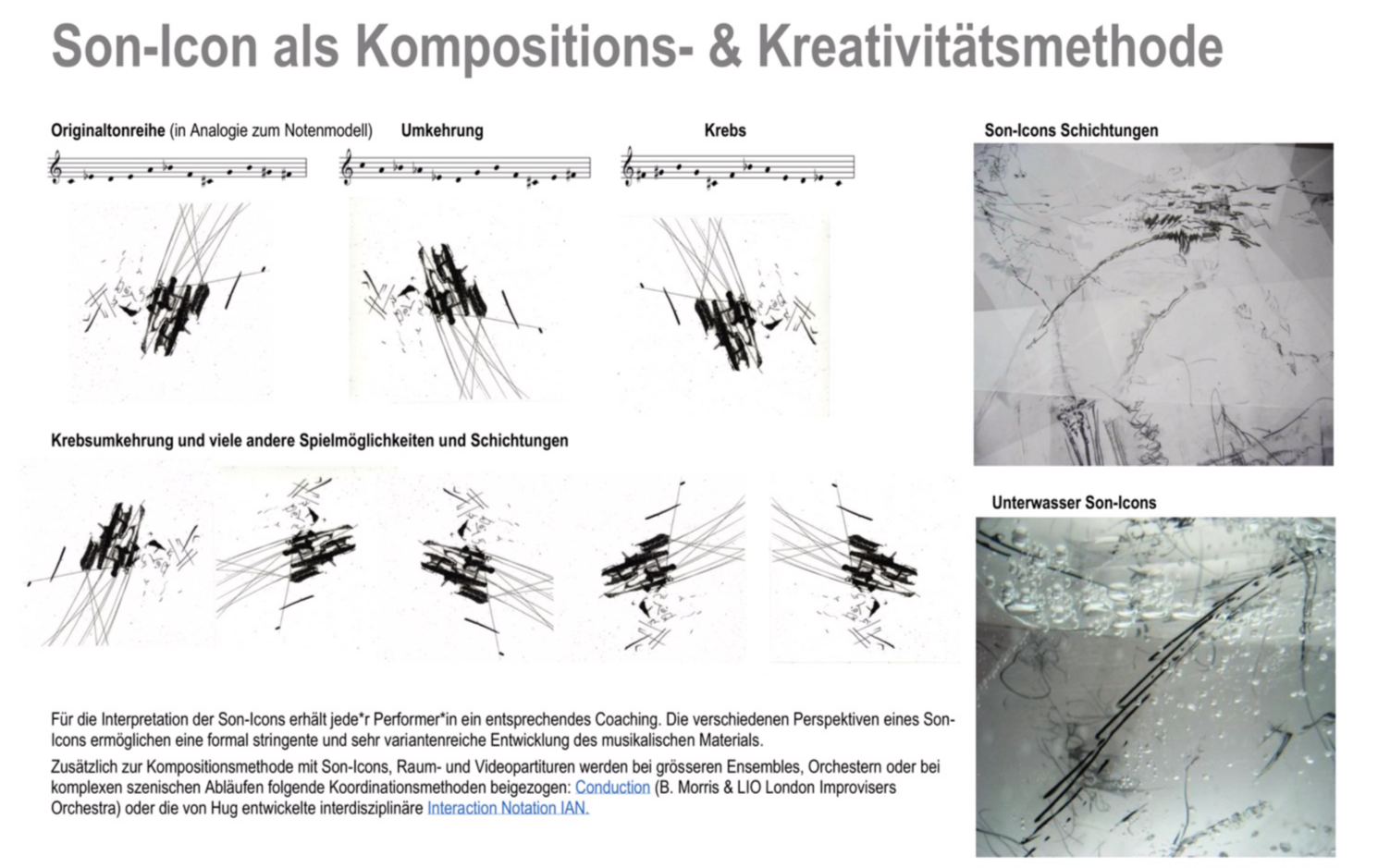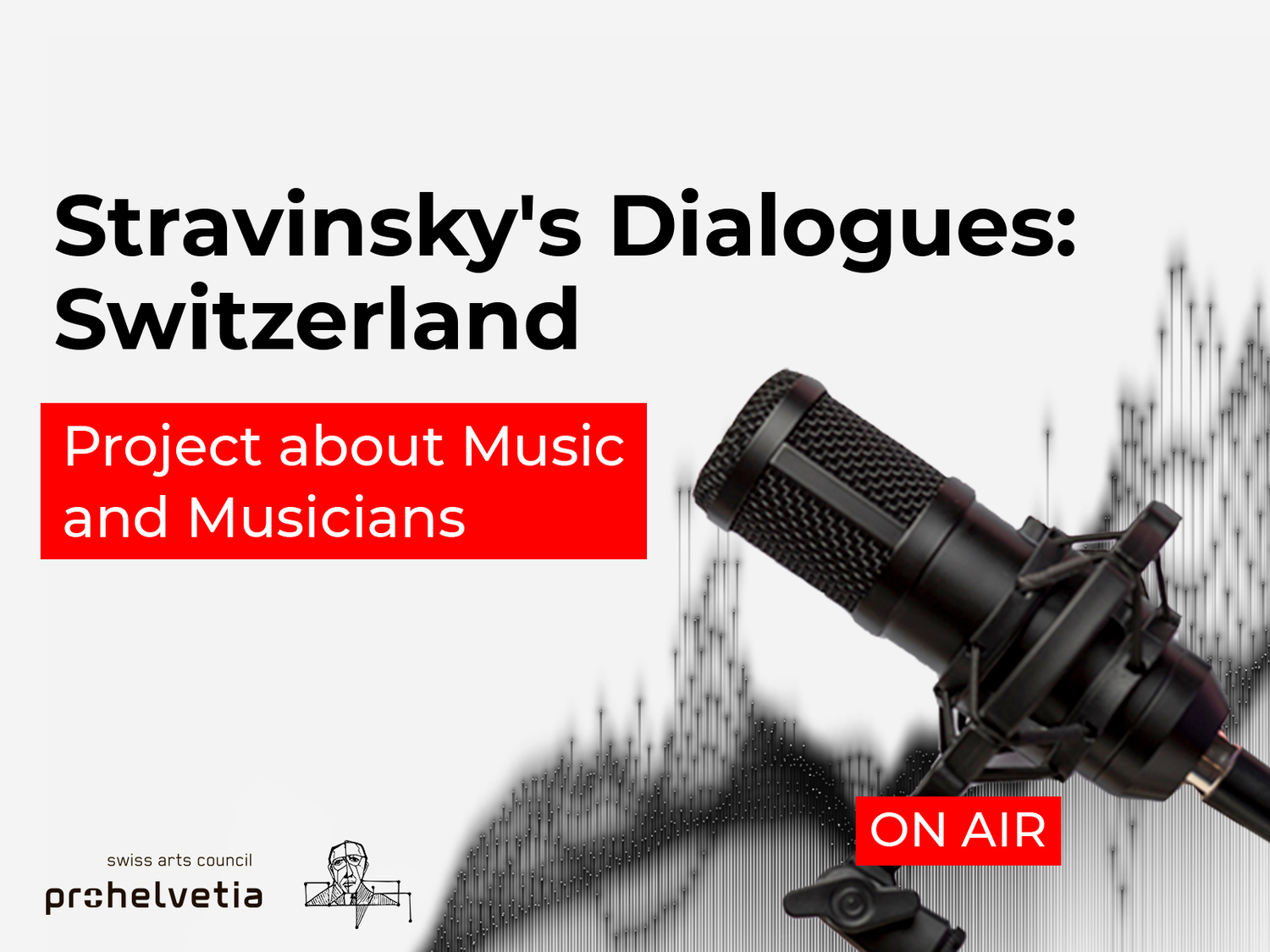

29/07/2021
Dialogue 2:
Charlotte Hug&Alexandra Persheeva
"I found multimedia on different continents"
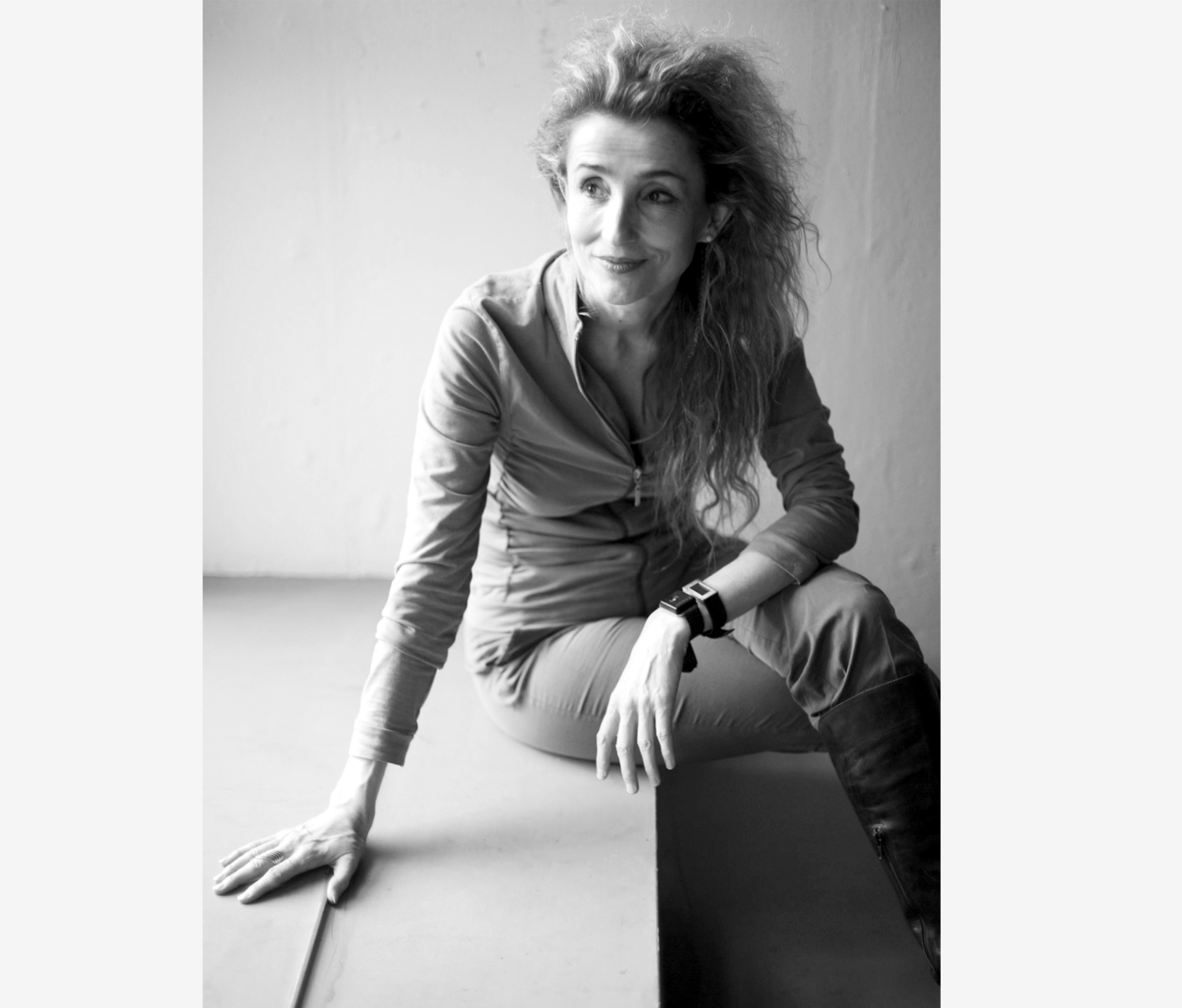
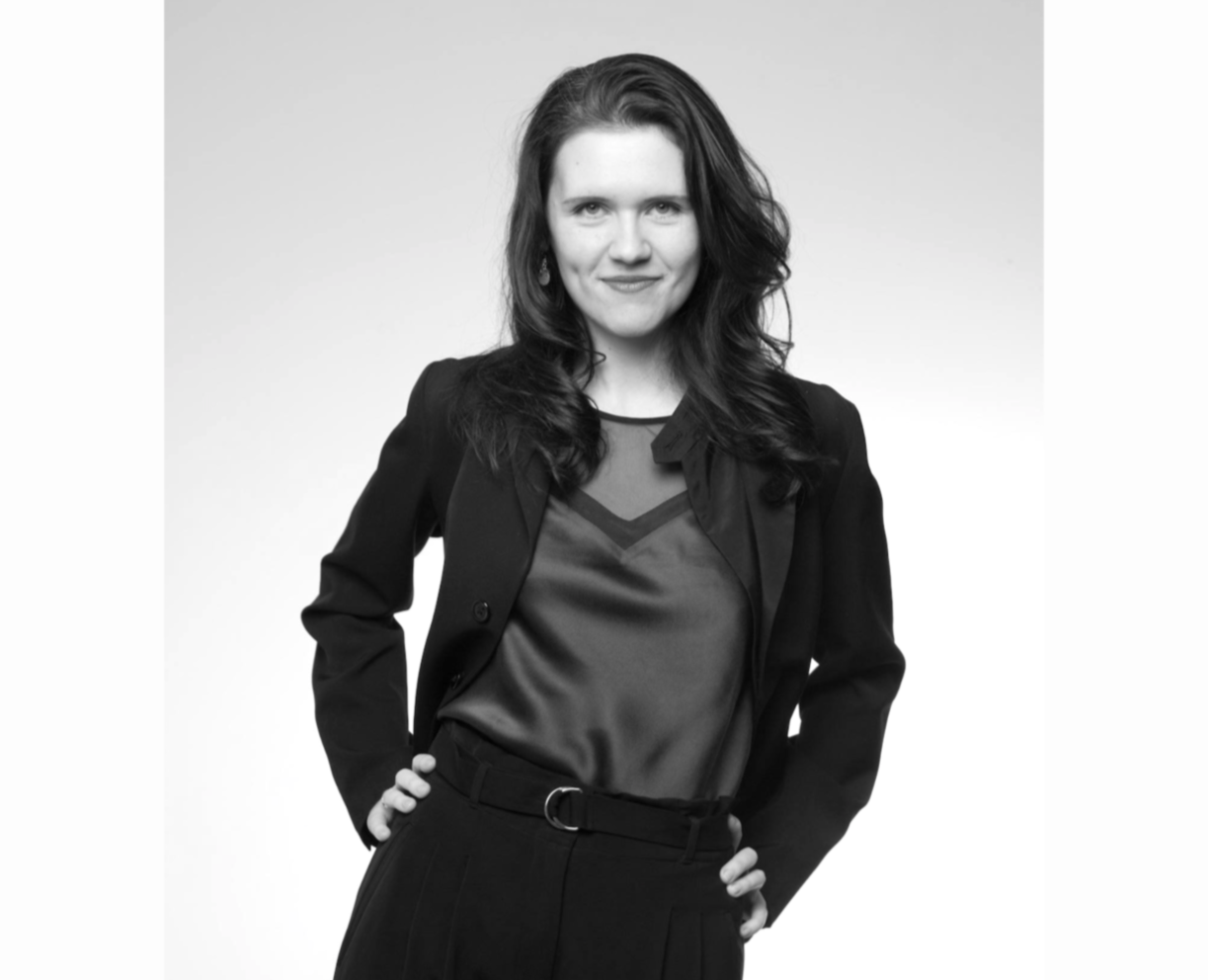
The guest of the second dialogue is a composer, performer, improviser, visual artist Charlotte Hug. The interviewer is Alexandra Persheeva, PhD in art history, a researcher, filmmaker, video artist, the head of the art history department at the Higher School of Economics Art and Design School.
Stravinsky's Dialogues: Charlotte Hug&Alexandra Persheeva
Обработка видео...
— Thank you Charlotte for coming. I’m very enthusiastic about your interview today. Saying in advance, I’m absolutely in love with your projects, especially with the visual material, the scrolls, everything. Hopefully, our viewers will be just as enthusiastic.
— Nice. Let’s dive into it. Thank you very much.
— Let’s start with the most intriguing thing, with your Son-Icon format, the format of visual music, dancing, drawing, singing — everything at one time. When you have such a multidisciplinary field, when you have a lot of mediums to work with, how does the project begin? Where is that first impulse coming from?
— That’s a very good question. I feel like I’m like a twin. There’s the ear and there’s the eye. Sometimes it’s a visual impulse, sometimes it’s aural imagination. Marshall McLuhan says, “The media is the message.” I’m interested in transdisciplinary approach since very very long. I think it’s the curiosity to dig deeper. When I started, I did a lot of drawings of outside noises, I did drawings in concerts. It was a curiosity to know how would that concert, how would that shape look. I was in the London tube very often with a small sketchbook and I did drawings with both hands just of the sound I heard. You know, Pauline Oliveros has the “deep listening” concept. Okay, I listen, but I want to visualize my listening experience. It really goes hand in hand. At the beginning it was a receptive attitude: I listened to urban sounds, to landscapes, to music. I just wanted to know more about it. If you have a visual medium that tells you other structures, they tell you other contents and narratives. So “the media is the message” has a very strong impact on me. I’m just curious, if I transfer one media to the others, what else do I get? As information, as feeling, as communication.
The beginning is the curiosity to know more, to feel more, to see more. I always felt the necessity to touch the sound. If you sing or if you play the viola, you touch the instrument or you’re the singing body. But to touch the sound itself? It’s kind of impossible. And for me, drawing the Son-Icon is either listening to real sounds or listening to sound imaginations. I always do drawings with both hands because we communicate with both hands. Sound is always communicating, it’s always resonant. If you’re happy, you’re resonant with yourself. We speak with both hands as well; it helps to support our communication. So, I take two pencils or even more pencils at once and paint with the right and the left hand. The left hand is another medium. The left hand tells you other things than the right hand. Another medium tells you another story. I’m very interested in that left hand knowledge. To me (I’m the right-hander), the right hand is very educated. And that’s a good thing, I mean, I studied visual art, and that’s very important, the studies and all the training. But the left hand in drawing is kind of that rough stuff, you know. As a musician, I feel like the left hand has a completely different training than the right hand. They are so different.
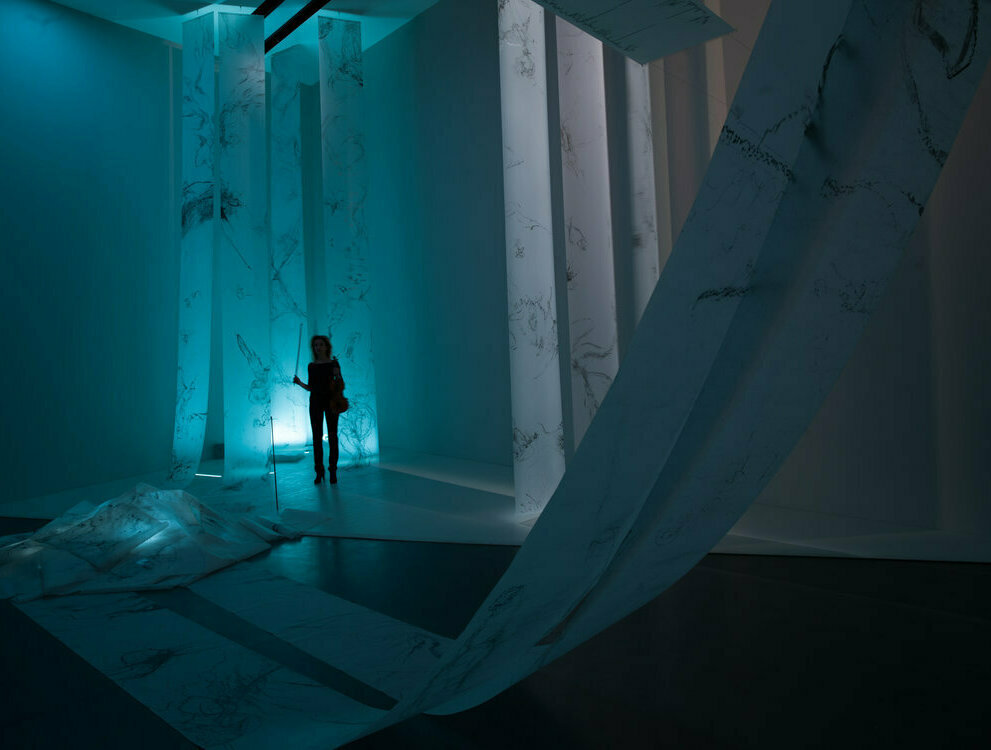
Son-Icons: spatial score & creative space
And there is Husserl, phenomenology. Of course you have an intention, you have imagination. You hear the sound, you sing the sound, you play the sound. But there is something in between, and that’s the primal gesture. And that primal gesture is not before and not after, it’s the act itself. Proust always thought, “I miss the present because I miss that primal gesture.”
So the Son-Icons are to capture something between a vision, a plan or something between “Oh, I should do this” and the result. For many many years I feel that my ongoing process has a potential for a lot of other musicians and artists. I’m a visual artist, I make exhibitions. Now I have a big solo exhibition “Resonance” in Bern at the Da Mihi gallery. People can just look at the Son-Icons and see autonomous visual art. They might establish a resonant feeling which is always dependent on the person who looks. It’s always in communication. So it’s visual art. But Son-Icons are hybrids. They are also a tool of research for my artistic processes. And I developed an intermedia and intercultural compositional method with it.
— When you talk about improvisation and switching between the visual and the audial there’s always a question of the mind/body gap. What you said meaning Husserl. Sometimes our hands create and we can’t even follow at the same moment, we follow in several seconds or several minutes. It takes us time to get the idea of what we have just done. Speaking about Son-Icon as a format comprehensible not only for you but also for other musicians, when you teach the performers, when you conduct an orchestra, how does it work? How do you explain these visual, poetical, musical scores?
— It’s actually very simple. I have three rules for the Son-Icons. They are always drawn with both hands on half-transparent paper. Of course I do video scores, I manipulate, I work with electronics but the primal thing is drawing. And they are never made on a table. They are always made on a surface. Because sounds are capturing or touching the surfaces. You see the frottage technique, you see the space or the surface where the sounds are reflecting. You have a sign, a Chinese character. I work a lot with Asiatic people. It’s a clear shape with open spaces and blurred edges. Then you can turn it by ninety degrees or another ninety degrees so you have four versions of one image. You can turn the page because it’s half-transparent. So on an analogue medium you have eight different versions of a Son-Icon. I tell the musicians, “If I give you one stimulus, you should look at the Son-Icon and develop ideas.” I always make coaching on how to read the Son-Icon. Then I say, “After a certain time you run out of new ideas. Ok, how can we dig deeper? Turn it around, make an essential stimulus and a clear shape. If open space goes upside down, that creates completely different sounds. But still the shape is the same. So you can…” There’s a clear reference to Johann Sebastian Bach and his compositional method but also the Second Viennese school with Schoenberg. Western-trained musicians are very fast to make connections with history.
Son-Icons
What really astonished me… I had a residency in China. I worked with traditionally trained musicians and they didn’t know the staff notation, the Western five-line staff. That was a big advantage. They looked at the signs and I told them, “Turn it around”. They made no reference to Bach and Schoenberg but they had visual intelligence to read and to capture the different energy, the different shape of that sign. I learned that this is not easily comprehensible when you have these historical Western roots. Maybe there is something universal in that Son-Icon, it gives a clear stimulus.
I was an artist-in-residence in Africa as well, I had a Pro Helvetia scholarship and I worked with South African dancers. I showed them Son-Icons and I told them, “You know, you can turn them…” It was difficult at the beginning. The first three days we were all searching, searching, searching. They told me, “It doesn’t go into our body, it’s just too abstract. We need narratives, we need images, we need people.” And I said, “Music is dance in my imagination.” I told them the story of drawing with both hands, that these drawings come out of a visceral knowledge and intelligence of the body. They said, “Okay, okay, okay.” The next morning Fana Tshabalala, the solo dancer from FATC company [The Forgotten Angle Theatre Collaborative], did a warm-up. He looked at the hanging Son-Icon, he moved it and I felt: now, he has it in his body. Dancers also have their own notation. Retrograde, retrograde-inversion, mirroring. So they could connect with their dance notation as well. [She means the project "SIYBA: found among translations", in which the members of the FATC troupe dance to visual music, and the musician translates body movements into sound].
I found multimedia in different medias, in different disciplines, on different continents, in different cultures. It gives a succinct stimulus of shape, energy, dramaturgy, innovation and creation.
Siyaba Found Among Translations
Обработка видео...
SIYBA: found among translations
— Absolutely. While you were talking about the Chinese musicians you worked with I was thinking that the Chinese language is very different from the Western world. Do you feel that the sound is not represented in the writing? The sound is one thing, the character is another. You look at a Chinese character and you don’t know how to read it before somebody tells you what it says. Perhaps that is the reason the musicians were more open. They were not expecting strict instructions: this is A, this is B, this is C. They have the experience of seeing a strange shape and knowing that it sounds like something, and I have to guess, I have to feel it somehow. So a Chinese musician or an African dancer have totally different intelligence, it’s just another type of seeing, feeling, thinking. It’s beautiful to have the possibility to work with such people.
If we think about different, estranged ways of comprehending, feeling, performing… Have you ever thought of teaching your Son-Icons to artificial intelligence? It thinks in a totally different way.
— You know, I teach Son-Icons as well, I did master classes all over the world. I teach at the University of the Arts in Zurich and at the Lucerne School of Music. They are both international. I think human beings are already so different that I don’t need to ask extraterrestrial people. But it’s a good question. It’s always communication and resonance. Each human being is such a universe itself that I’m curious to discover the sound of the universe of that person or extraterrestrial species. It can be very weird. I worked with Chinese musicians and we didn’t have a common language but we had Son-Icons. I was with a filmmaker Alberto Venzago for the “Voodoo” film in Benin. These cultures are very different. The world is so big… I can answer your question just by meeting those people. I’m also interested in small cultural differences. For example, I had a commission from the Moscow contemporary music ensemble. They wanted to improvise, I wanted to work with video and multimedia. Then I thought, “They are fantastic musicians. I want to meet their level but with a multimedia or transdisciplinary approach of the Son-Icon.” That’s when I did a lot of research. I thought, “Of course they know all kinds of notation perfectly well. But they don’t know the Son-Icons. What can I do to make them stimulated?” And then I worked with professor for phonetics in Russia. I asked her what are the natural resources that the body, the language, the voice has. She told me, “Yeah, in Russia…” You know it, of course. “There is one sign that makes sounds softer or sharper.”
— Yeah, I know of course.
— It’s a very simple thought but I developed it much further. Russian people speak this language since early childhood and they have a special affinity for these almost homeopathic differences between sharp and soft. I did a lot of research concerning mouth and phonetics. My professor taught me the alphabet and all the special sounds. I did drawings and now I have an exhibition. I studied the direction of the airstream, the vibrating parts of the mouth. Then I made an eleven-meter long Son-Icon with topography of the mouth. It’s not just Russian but thirteen other languages. But I made a special research with Russia. And that was the score. [the work «Hard-flowing-transparent»].
Inter-media Composition (full length) by Charlotte Hug HARD-FLOWING-TRANSPARENT
Обработка видео...
Hard-flowing-transparent
I gave the score to the Moscow contemporary music ensemble and I explained, “Say this or that vowel, how does it vibrate in you? How can you translate this old knowledge you have into your clarinet, your violin, your piano?” Son-Icons are open but also very specific. I motivate the musicians to go beyond their normal habits, to create music. I think it worked well, they played like gods. I felt they were satisfied with their discoveries of new sounds connected to their personal history but translated in a very artistic way.
Son-Icon always needs interaction and structuring methods. I have a trio. I often conduct Son-Icons. The conduction is often initiated by the London Improvisers Orchestra. I also use the European version of conducting [«Conduction», the method of American composer and improviser Lawrence Douglas Morris, which allows you to coordinate the actions of musicians in large ensembles to create music in real time]. It’s over twenty years of artistic research that the London Improvisers Orchestra does and still is doing.
The third method is interactive notation [«Interaction Notation» (IAN)], it’s interdisciplinary and intercultural. It’s an interface where you can incorporate Son-Icons but also staff notation and video scores. It really stimulates the interaction between the musicians. All the students love it because interaction is music.
— Charlotte, there is another thing I wanted to ask you. You always mark that thing about interaction, communication, that life process which is very important. I have two questions concerning that. One: how does it feel making site-specific performances, like in a glacier or urban areas? Does it feel like you make the places sound or you communicate with place, you play together? How does it work?
— I just listen a lot. I’m a listening person. Sometimes I make sounds like a bat. Not to feel the room, not to make a concert in that site-specific arena but to create echoes. I make echolocation with my voice.
— Your regular voice?
— With my voice, yeah. I listen, I do recordings and I do drawings on-site. I had a residency in Switzerland last summer. I worked there for several weeks and I used to take the same route in the morning and at night. I want to get to know the space in different temperatures, in rain, in the sun. I fall in love with the place I play, even if it’s a very rough place. Then I can create. I always have a different approach. For example, in the glacier I made a ten-year project and I went into the tunnel of the glacier. The glacier melted more and more and more. It got 86 meters shorter within ten years. The concept is that I’m in a resonance body (the glacier) and my sound body gets smaller and smaller. My concert hall gets smaller and you can hear that. Of course it has a political message but it’s always an esthetic experience. You hear the space get smaller and the walls get thinner. You can hear the climate change.
Rhône
Обработка видео...
— That’s a great idea, hearing the climate change. What impressed me in the video was that you touched the ice with your hands and feet. It was so unusual. Did it make you happier, did it make you more alive? What did you feel?
— Touch is important, I want to touch the sound. If you make a vibration, if you sing in a glacier, the glacier vibrates. Microvibrations. I want to touch the space that vibrates. Of course the glacier is very cold. When I touch it I get more or less the temperature of the glacier. It transforms my body. I got very cold, my fingers got almost numb so I could not touch the instrument, I could not play like a normal person. I had no strength in my fingers because they were so cold. I played and I could not press the strings down which created some special overtones. It took me almost three years to recreate those overtones in a normal concert hall, to find that precise moment when the strings were not touched and the overtones were created. So I always go 1000% into space.
— My second question is a bit tricky. You are very devoted to your colleagues, the places, the instruments, the violin, the paper, the glacier, whatever. How did you feel during the covid, the lockdown, when all the concerts were cancelled and we were totally online? Did you perform in those circumstances? How did you feel the audience, the colleagues, the process when it was like that, digitalized?
— Of course it’s very different. And as a singer… I mean, there were no concerts, no real dialogues. As a singer I felt like the mouth was a very dangerous part of the body for others. And the breathing, the air. I did some concerts with a mask on. I developed a technique not exhaling while singing but inhaling. I thought, “Okay, exhaling is just one thing a singer can do. Right now it’s not the thing to do.” I used to stop breathing whenever I met somebody on the road. Breath is danger for others. I developed a lot of techniques while inhaling like… (shows) Things like that. It’s all inhaled. They can get into vibration by exhaling and inhaling, that’s physics. I’m still very much into that. So I actually have a new field of research.
But that’s for me alone in the studio. The London Improvisers Orchestra kept doing their concerts online. Caroline Kraabel went into the streets and conducted near musicians’ windows. They saw Caroline Kraabel conduct through a window and they played. She conducted me while I was in the Swiss mountains. We tried not to lose the body. Conducting is reading somebody’s body, the thinking body, the dancing body. I think the body got even more important.
— We value it more, the touch, the space, meeting someone, being somewhere. Speaking about touch, are you practicing something like sculpture? You can hang up your scrolls, okay, but maybe you can make circles of them, I don’t know, some constructions. You could work with clay, with whatever you could touch. Isn’t that an interesting thing?
— Absolutely. I do three-dimensional scores on different levels. I did bodies of sound after my residency in China, I brought a lot of silk back home. They use silk for landscape painting. It’s a very thin silk. Normally they put the silk on a surface, water, you know. The silk is full of rice glue. I did a drawing with ink and I put the silk into water. You can make a shape out of glue and it stays. I also made sculptures out of silk. They are very big. I made an exhibition in China at the Hangzhou Academy of Art with original silk sculptures. I filmed those sculptures and I made a video animation so the drawings got a three-dimensional room and a 360-degree projection where you are really in the space. Or animation, or 3D animation. Water’s always animation.
SONOTOPOI music and visuals by Charlotte Hug
Обработка видео...
Sonotopoi
I also have mobile projectors. You can project on objects, on the walls, on architecture. What I like is that the room itself gets a score. For example, the Moscow Multimedia Art Museum has a stairwell and it’s eleven meters high. I made a Son-Icon analogue score, an eleven-meter mobile Son-Icon. It’s a score because I left a note to the musicians, “Look on the top third of the score.” Then they make a movement with their clarinet and their body. The sound diffusion is also different. I do special scores of the Son-Icon. Musicians move with their instruments because they look at different parts.
The Son-Icons might be small sketches, but sometimes… The longest score is 86 meters long. In Russia I had an eleven-meter score combined with animated video and choreophony. Not choreography but choreophony, how musicians move into space. Alexandrinsky Theatre in Saint Petersburg is a theatre stage. For each stage I do a choreophony, how the musicians move into space. I always get the plan of the space because the space becomes the score. In a way it’s three-dimensional.
— Okay. How about virtual reality? For example, you can create 3D Son-Icons and one can walk into them.
— Yeah. I collaborated with the Institute for Computer Music and Sound Technology at the Zurich University of the Arts. We had immersive installations with ambisonic sound and three-dimensional sound 360-degree projections. I love that. You can never see the full score because you only have one direction. It’s close to the way we experience nature and urban spaces. We never have the overview. But we can hear three-dimensional. I’m fascinated by three-dimensional sound diffusion and the limitations of the eye. We don’t have eyes on our back, but we can listen. I’m interested in this phenomenon that the eye is different than the ear. I work with ambisonic and immersive installation. And also a resource project with Linda Bouchard in San Francisco, the Matralab. She made interactive scores with algorithms so that the scores could learn what musicians play. I’m interested in the drawing itself but also in the possibilities of a computer. But it does need to make sense artistically.
— Absolutely. It’s very intriguing what technology can allow us to do, how it can stimulate us. New media are very interesting, they make me wonder what’s going to happen, what will come out in ten years, in twenty years.
— Yeah.
Charlotte Hug, Jose Lopez-Montes BADLANDS TO THE SKIES - VISUAL MUSIC
Обработка видео...
Badlands to the skies
— The final question is the most intriguing one. Let’s fantasize. If you could have any technology, the technology no one has ever imagined, what kind of technology would you like to have?
— Wow, that’s a very good question. There are telematic concerts where people from different continents play together. At the Zurich University they do a lot of telematic concerts with people from different continents. What is missing in my opinion… Of course there is delay and everything, of course we have this super technology. But I’d like to have a technology that can bring people’s energy, the aura of a person. On an energetic level nothing goes closer to sharing. How can I really share an experience? I’m thinking about an immersive technology but not just overwhelming with stimuli and sounds. What I missed during the pandemic was sharing the real experience. Of course we don’t want to travel too much. It’s a big issue for a musician. Live is fantastic, intercultural is fantastic but you have to travel. And if that ambivalence could be resolved to get into a deep human artistic esthetic encounter, if technology could create such an environment, that would be fabulous.
— I strongly believe that the scientists can hear us. The artists, the poets, the writers create ideas that later become technologies. So my question was not in vain. Hopefully, someone’s going to hear us. I would like to note that today, even though we are communicating through Zoom, I did feel quite a lot.
— Likewise.
— Thank you for the interview. Looking forward to seeing your Son-Icons in performances made by you and your colleagues.
— Thank you so much, Alexandra. Technology is already fantastic. I feel so connected to you, it feels like a real encounter.
—Hopefully, our viewers are going to feel the same way.
